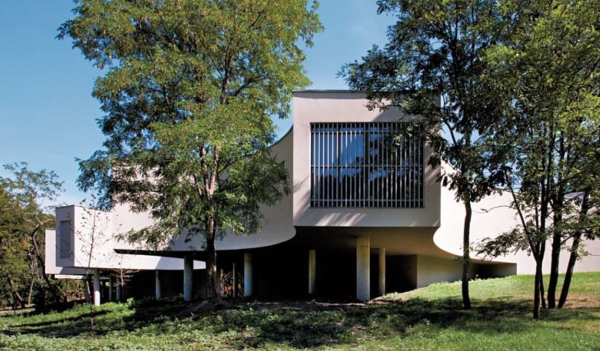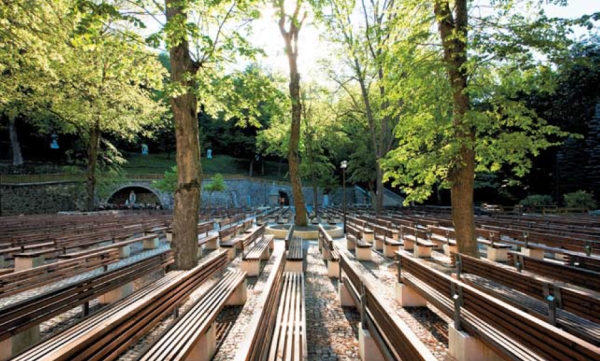We are All Pilgrims
The Rehabilitation and Extension of the National Pilgrims’ Site in Mátraverebély-Szentkút
Architect: Tamás Nagy
Text: Miklós Sulyok
Photos: Tamás Bujnovszky

As a rule, a pilgrims’ site is traditionally the venue for reconciliation and coming to terms with God. Such sites have typically evolved where miraculous events took place according to tradition or local legends. Here in Nógrád county, the villages of Mátraverebély and Szentkút take pride in their first miracle dating back to the 12th century. Their devotional church and chapterhouse still standing today were erected in the 18th century.
The sacred complex in Szentkút is located some five kilometres from the village itself: it nestles at the mouth of the valley of in Mátraverebély right on the edge of the forest. The modest pilgrimage site with the Baroque-style church completed with a few modestly sized other buildings that are hidden here and the Calvary flanking the edge of the forest invokes nature to help us to subside into resilience. The project including both the revival and the extension of the pilgrim’s site necessitated a unique architectural design stage targeted to preserve the natural environment and couleur local too. The Franciscan community maintaining the pilgrims’ site required tranquility and enclosure, whilst its members also have to provide services to help the pilgrims who continuously arrive at the site in large numbers, especially for the major holidays.
Approaching Szentkút along the main road, we hardly notice the buildings: the single-storey dormitory hosting visitors appears to blend with the hill almost entirely until we get to the reception building (yet another bungalow-design structure) which stops us with its arc-shaped colonnade which symbolizes the welcoming gesture of an embrace. This building houses the reception, a souvenir shop, a projection room as well as the public conveniences. The simple materials used, the exposed concrete columns, the light grey plasterwork, the large expanses of glass as well as the grey metal structure of the portal are all orchestrated to contribute to the integral impression of the architecture of the whole complex. Seated on an embankment, the building has a rear side articulated by semi-circular bays. The foil-shaped horizontal plan is derived from the shape of the leftover host when making the sacred bread. Leaving the reception building and walking on the path which runs parallel with the Calvary in the forest we arrive at the yard of confessionals. The roofing above the open-air confessionals which is actually the deck of the chapterhouse as well as the tapering concrete pillars supporting it have been transformed to a minimum extent while building the suspended ceiling to conceal the rain gutters of the roofing and installing the new railings of the deck. The basilica has been restored entirely as a protected historic building. The iron gate functioning as the entrance has been removed, the new tiling of the floor is made of travertine which favourably lightens the interior without quelling the mysterious gloomy atmosphere of the church. The old Baroque-style main altarpiece has been restored to its old glory, the devotional statue is placed lower, the powerful and unadorned stone mass of the main altar links to the eventful dynamic Baroque-style main altar by advantageously counteracting it.

The open-air site for celebrating the masses is the other liturgical focus of the complex, where several thousands people are present to take part in the sacred ceremonies during the most significant pilgrimage events. The former statue portraying Mary has been placed into the abutment beneath the calvary whilst in its former place there are now new mosaic compositions to grace the wall behind the altar. The rows of pews have also been replaced with new ones, the trees clad with their stone brims, the newly regulated streambed and railings also contribute to a better kept overall impression of the venue. The front slab of the open-air altar has a rustic finish, whereas the altar of the basilica is also made of brick but has been rounded off by a smooth finish.
Behind the basilica among the apse, the chapterhouse, the pilgrims’ house and the forest there is now the new gallery of the chapterhouse to the utmost pleasure of the friars living here. This is how the building actually transformed into a genuine monastery. Owing to the features of the natural terrain, the cloister gallery has a terraced design with graded level shifts which created unique spatial effects. On three sides the quadrum is bordered by a wooden wall surrounding it which appears as a timber structure when viewed from the outside. Nestling into its natural environment, and expressing Franciscan poverty in an authentic way, the gallery wall built from wooden planks also marks that it is far from being a luxurious facility for tourists: it is a pilgrimage site easily affordable and available for ordinary believers. Supported by timber columns and covered with zinc plating, a roofed-in gallery joins the circular wall on the inside. The centre of the site has been reserved for a sacred element: the water with curative effects seen here in the form of a fountain designed as a simple block. As the apse of the church has intruded into the quadrum, the circular corridor fails to surround it, which in itself is an architectural solution reinforcing the impression of an extraordinary design concept.

Of the two pilgrims’ buildings the one named so was built to integrate with the old chapterhouse to house double rooms and a restaurant: originally built in the 1930s, it was converted now by replacing its former saddle roof with a more gently steeped one, an upper storey with a loggia: besides, a roofed deck to extend the restaurant was also built in front of it. Just like elsewhere, the simple forms and materials used here define both the exterior and interior design of the house: the homogenuous plastered sand-coloured wall expanse dominates the exterior whilst the travertine floor tiling integrates the interiors of the house. The facade is enriched with sliding window panes equipped into rails attached to the wall and a row of loggias wrapping around the second storey. The second building referred to as the pilgrims’ accommodation or dormitory is a new single-storey structure seated at the foot of the hill. Because of its green flat roof it appears as if it were an integral part of the hill. The building which is 300 metres long contains the public conveniences, a conference room and three accommodation units (a dormitory for groups, a kitchen with a lounge and wet areas). Its horizontal plan from the direction of the hill follows the contours of the terrain with its broken lines, whilst it is subdivided into smaller units towards the open space. With a perfectly working and viable concept, the architect placed a system of grilles made up of timber columns standing on small concrete trunks along the full length of the building, much like a porch in front of the facade, which almost entirely hides the structure from sight. These „porches” are in-between spaces: when staying here we are in nature whilst also feel sheltered by the building. Two powerful and yet unnoticed architectural gestures co-ordinate the complex as such: the tilings and facework of the exterior and interior. The tiny blocks of exterior tiling extend from the reception building to the edge of the forest, stretching as long as 400 metres whilst tracing versatile patterns. The quiet and noble travertine of the interiors accompanies visitors from room to room providing a calm integrity of the units embraced within the architectural space.
Tamás Nagy, who is one of the most prominent figures of contemporary church architecture in Hungary, designed churches now internationally renowned and acknowledged. When designing this complex in Szentkút, his models were, as he says, the architectures of Sigurd Lewerentz (Sweden), Rudolf Schwarz (Germany) and the Flemish Hans van der Laan. When speaking of these exemplary masters, he emphasized the importance and significance of deep silence and tranquillity as well as monumental dimensions and simplicity. All three of these architects have unconditionally devoted themselves to puritan styles, unadoredness and the exposure of natural materials used. The primary question of the architectural work of Tamás Nagy in Szentkút was how to transform a pilgrims’ site in the depth of a forest so that its architecture would permit the evolution of the spiritual peace and quiet associated with pilgrimages and prayers in their entirety. His beautiful and highly convincing response is embodied now in Szentkút.
General architecture: Lint Kft.
Leading architect: Tamás Nagy DLA
Fellow architects: Csongor Szijjártó, Anna Meditz, Zsófi Sziray, Kinga Radnóczi, Lili Hajdú, Tamás Lévai, Balázs Vörös, Gabi Elekes, Mátyás Holló
Structure: Gergely Dobszay, Csaba Hadnagy
Interiors: Erika Ignácz
Landscape: Csenge Csontos†, Bori Gyüre
Statics: Balázs Puskás, Zoltán Késmárky
HVAC: Péter Dobner, Attila Buda
Electrical engineering: Bence Antal, György Bertalan
Lighting: Ferenc Radnóczi
Public utilities: Mária Lambert, Andrea Zuppánné M.
Client: Magyarok Nagyasszonya Ferences Rendtartomány
Main contractor: Confector Kft.











